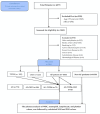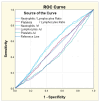The Role of Neutrophil-to-Lymphocyte Ratio and Platelet-to-Lymphocyte Ratio in Predicting Atrial Fibrillation and Its Comorbidities
- PMID: 40566612
- PMCID: PMC12193945
- DOI: 10.3390/life15060960
The Role of Neutrophil-to-Lymphocyte Ratio and Platelet-to-Lymphocyte Ratio in Predicting Atrial Fibrillation and Its Comorbidities
Abstract
Atrial fibrillation (AF) is one of the most common cardiac arrhythmias encountered globally, characterized by a pro-inflammatory pattern. This analysis evaluated the neutrophil-to-lymphocyte ratio (NLR) and platelet-to-lymphocyte ratio (PLR) in patients with AF alongside chronic kidney disease (CKD) and/or type 2 diabetes mellitus (T2DM). This retrospective cohort study included 6077 patients admitted to the Third Medical Clinic of Saint Spiridon Hospital in Iasi from 2018 to 2023, all diagnosed with AF, CKD, and T2DM. After applying the exclusion criteria, 1066 AF patients remained eligible. For a multivariate comparative analysis, the patients were divided into groups: I. control group (non-AF patients); II. AF patients; III. T2DM group; IV. CKD-only group; V. AF+CKD group; VI. AF+T2DM group; and VII. AF+T2DM+CKD group. The Mann-Whitney/Kruskal-Wallis test demonstrated a statistically significant difference in NLR and PLR values between the AF group and the non-AF group (H = 70.627, p < 0.001). The receiver operating characteristic (ROC) analysis identified statistical significance and predictive power for NLR (AUC = 0.722; sensitivity = 63.6%; specificity = 76.9%) and neutrophil count in diagnosing AF, T2DM, and CKD. In conclusion, this study illustrated the utility of NLR and PLR as readily available and predictive biomarkers of inflammation in patients with AF, with or without comorbidities.
Keywords: AF; CKD; NLR; PLR; T2DM; atrial fibrillation; chronic kidney disease; neutrophil-to-lymphocyte ratio; platelet-to-lymphocyte ratio; type 2 diabetes mellitus.
Conflict of interest statement
The authors declare no conflicts of interest.
Figures



References
-
- Van Gelder I.C., Rienstra M., Bunting K.V., Casado-Arroyo R., Caso V., Crijns H.J.G.M., De Potter T.J.R., Dwight J., Guasti L., Hanke T., et al. 2024 ESC Guidelines for the management of atrial fibrillation developed in collaboration with the European Association for Cardio-Thoracic Surgery (EACTS): Developed by the task force for the management of atrial fibrillation of the European Society of Cardiology (ESC), with the special contribution of the European Heart Rhythm Association (EHRA) of the ESC. Endorsed by the European Stroke Organisation (ESO) Eur. Heart J. 2024;45:3314–3414. doi: 10.1093/eurheartj/ehae176. - DOI - PubMed
-
- Joglar J.A., Chung M.K., Armbruster A.L., Benjamin E.J., Chyou J.Y., Cronin E.M., Deswal A., Eckhardt L.L., Goldberger Z.D., Gopinathannair R., et al. 2023 ACC/AHA/ACCP/HRS Guideline for the Diagnosis and Management of Atrial Fibrillation: A Report of the American College of Cardiology/American Heart Association Joint Committee on Clinical Practice Guidelines. Circulation. 2024;149:e1–e156. doi: 10.1161/CIR.0000000000001193. - DOI - PMC - PubMed
LinkOut - more resources
Full Text Sources

